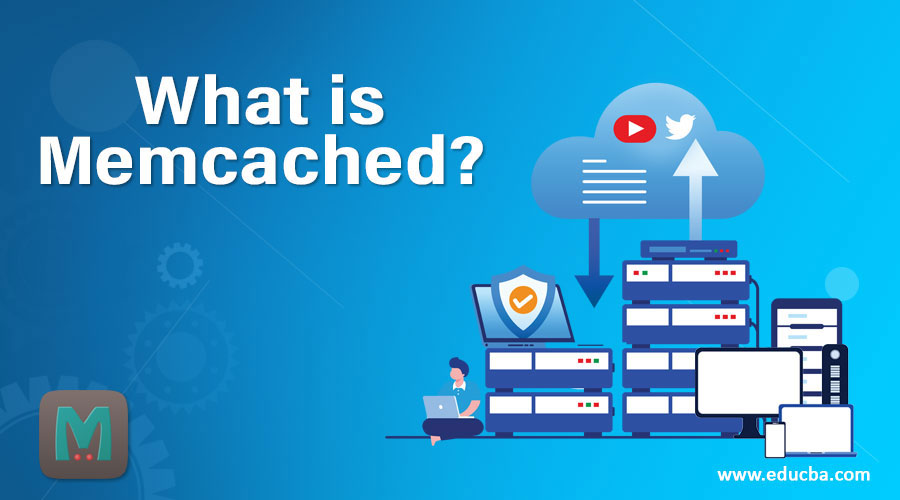Updated March 27, 2023

Introduction to Memcached
Memcached is a high-performance free, open-source cache framework for distributed objects. It is used for accelerating dynamic web applications by loading the database. The websites have huge information they use the Example: Twitter, Youtube, and Wiki, etc. One of the key things you can do to speed up the website properties’ delivery is to have the correct cache arrangements in place.
Memcached is a memory encryption program distributed open source. It is used to reduce database load and speed up dynamic web applications. In other words, this adds additional load to the server each time a database request is made. It reduces the load by saving dynamic memory data artifacts. Store this data for small arbitrary strings or objects based on key values, including Page rendering, Result of database cells and API cells. Four main components are composed of Memcached. These parts allow cached data to be delivered efficiently by the customer and the server in conjunction:
- Server Software
- LRU
- Client Software
- A client-based hashing algorithm
When information is updated, or an item’s expiry value expired, Memcached updates its cache to make sure the customer gets fresh information. To order to keep its records up-to-date, it relies on replication and redundancy within its various databases. It consists of multiple database files, which have a central DBMS power.
Features of Memcached
Following are some of the features of Memcached:
- It is an open-source.
- It’s a UDP or TCP server-client program.
- As a standalone service, Memcached works. So the cached data will remain in memory while the service is running when you download your application.
- The cache nodes are very ignorant, so they don’t know other nodes involved. This makes it extremely easy to manage and configure such a device.
- Under the license of Berkeley Software Distribution, distribution has been done.
- It reduces the database load.
How does Memcached Work?
Memcached has four major components, which make it possible for it to save and recover data, as described above. The name, expiration date, and raw data are included in every object. At a Memcached high level, the following works:
The customer must request a piece of data and then search it for the cache. Two possible outcomes may be available:
- Restore Data: Restore data from Memcached if data is saved in the cache.
- The Cache Does Not Contain the Data: scan, retrieve, and store the Memcached database.
Whenever data is updated, or an object has an expiry value expired, it updates its cache to provide the customer with fresh content. This system involves many servers and many customers from it. For the use of Memcached storage servers, clients use a having algorithm. This helps to spread the load. The server then calculates the second hash of a key to figure out where the corresponding value should be stored in an internal hash table.
- Some Key Stuff About Memcached Architecture is: Installing the Memcached.
You can use this in a couple of ways. The process can vary depending on the program you are using. The installation of a package is easy, as described on the official Memcached Installation Wiki. Use the following code if you are using Ubuntu or Debian:
Command:
apt-get install MemcachedUse the following for users of Redhat / Fedora:
Command:
yum install commandYou may want to find many different ways to install Websockets depending on your requirements as defined in the Wiki. It’s highly recommended to check out your full Wiki hosted on GitHub if you want to know more about its setup, use, and maintenance.
Advantages and Disadvantages of Memcached
Following are the different advantages and disadvantages:
Advantages
- It stores the data on the server.
- It is efficient and Cheap.
- This can be used in many platforms such as mac os, Linux, Unix, and window.
- It can compensate inadequate ACID properties, and it never blocks.
Disadvantages
- It’s quite slow, mainly due to serialization or deserialization and network latency, compared with the In-Memory cache.
- There is limited access to the same data package by more than one user, as there is just one copy and held in one location.
- The datastore is not permanent.
Conclusion
It is not difficult to implement in your program, but you need to think carefully about this subject since things that don’t exist can’t be found. Usually, information that is difficult to update, or repeated requests like a database, is intended to cache.
Recommended Articles
This is a guide to What is Memcached? Here we discuss the definition of Memcached and how Memcached works along with different features, advantages, and disadvantages. You may also have a look at the following articles to learn more –

